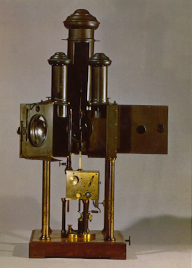
52.5 x 17 x 13.5 and 92 x 37 x 38.5
Brass, copper, steel and wood
CAT. 1878 : 472
Regulador photo-electrico de Foucault, com sua lanterna.
Photo-electric regulator by Foucault, with its lamp.
The graphite electrodes, with artificial lighting devices, decrease in intensity as a result of the combustion observed at the instant of electrical discharge. This occurs once the distance between the two points of the electrodes is gradually increased until there is sufficient electrical current to maintain the process of electrical discharges. This problem was solved in France by Foucault and in England by Staite and Petri, in 1848. It was at this time that the first electric light regulators, or voltaic arc lamps, appeared. These had mechanical systems controlled by an electromagnet, enabling an ideal distance to be maintained between the points of the electrodes so as not to interrupt the process of electrical discharge.
The application of these regulators to illumination systems greatly widened the scope of artificial light. The excellent lighting conditions thus obtained contributed to the first steps in photography. Voltaic arc lamps have characterised the development of the cinema. The use of these lamps for street lights testifies to their efficiency, given that a single lamp would give reasonable illumination. Using voltaic arc lamps with Foucault's regulator for public lighting became very expensive, however. This led to the appearance of another type of lamp in which the two electrodes were placed close together, parallel to one another. The lower ends of the electrodes were attached to a piece of metal connecting them to electrical conductors from the power supply. These electrodes were coated with an insulating substance, which was fused to the electrodes close to their tip because of the high temperature caused by the combustion of the graphite. Only the tips of the two electrodes, therefore, were unaffected by the insulating effect of this substance. The unit was installed inside a translucent glass sphere to give good lighting. A system of automatic polarity inversion of the electrodes was used to prevent uneven wear of the electrodes. In fact the electrodes do not wear out in the same way because the negative electrode increases in mass, when used normally, as particles accumulate at its tip. It is possible to observe this phenomenon with a microscope, as the incandescent particles pass from the positive to the negative electrode of an arc lamp with iron electrodes.
Among its collection of instruments, the Gabinete de Física in Coimbra has a Foucault regulator which is installed in a projection lantern used for experimental optical studies. Its design is similar to the magic lanterns in use in the 18th century. The only difference is that this voltaic arc lamp is more powerful than that used in magic lanterns. The size of the instrument means that the tips of the graphite electrodes are placed in the focal area of the convergent lens. On the side opposite the lens, inside the lantern, there is a concave mirror. This reflects the light shed on the back of the lantern, through the lens, considerably increasing the intensity of the beam of light emerging from it. On the outer end of the tube holding the lens, there is a round collimator which revolves on its central axis. This collimator has several differently sized orifices arranged on an arc of the circumference to permit the selection of different openings for the beam of light.
The upper part of the lantern's casing has three chimneys of different sizes to allow the escape of the gases produced by combustion of the graphite. The middle one is the largest and has a window through which the arc lamp is installed or removed. For this to be done, a door in the back of the casing has to be opened.
The instrument in the Gabinete de Física is dated 1865.
Daguin, Pierre-Adolphe, Traité Élémentaire de Physique Théorique et Expérimentale, Paris, 1878, Vol. III, nº. 1943, 2347, 2350, 2352 and 2353.